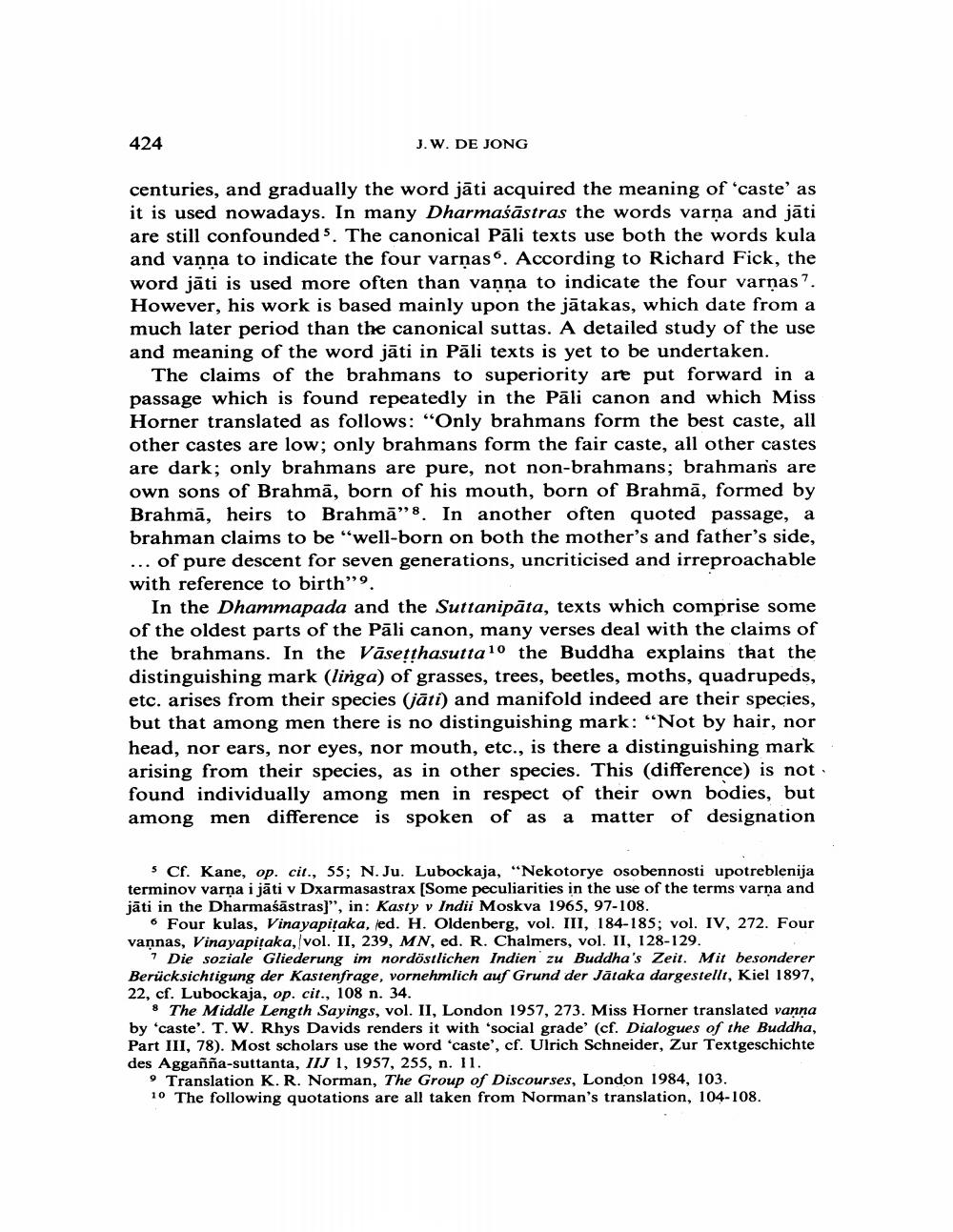Book Title: Buddhism And Equality Of Four Castes Author(s): J W De Jong Publisher: J W De Jong View full book textPage 2
________________ 424 J. W. DE JONG centuries, and gradually the word jāti acquired the meaning of caste' as it is used nowadays. In many Dharmaśāstras the words varņa and jāti are still confounded. The canonical Pāli texts use both the words kula and vanna to indicate the four varņas. According to Richard Fick, the word jāti is used more often than vaņņa to indicate the four varņas?. However, his work is based mainly upon the jātakas, which date from a much later period than the canonical suttas. A detailed study of the use and meaning of the word jāti in Pāli texts is yet to be undertaken. The claims of the brahmans to superiority are put forward in a passage which is found repeatedly in the Pāli canon and which Miss Horner translated as follows: "Only brahmans form the best caste, all other castes are low; only brahmans form the fair caste, all other castes are dark; only brahmans are pure, not non-brahmans; brahman's are own sons of Brahmā, born of his mouth, born of Brahmā, formed by Brahmā, heirs to Brahmā”8. In another often quoted passage, a brahman claims to be “well-born on both the mother's and father's side, ... of pure descent for seven generations, uncriticised and irreproachable with reference to birth"). In the Dhammapada and the Suttanipāta, texts which comprise some of the oldest parts of the Pāli canon, many verses deal with the claims of the brahmans. In the Vāsetthasutta 10 the Buddha explains that the distinguishing mark (linga) of grasses, trees, beetles, moths, quadrupeds, etc. arises from their species (jāti) and manifold indeed are their species, but that among men there is no distinguishing mark: "Not by hair, nor head, nor ears, nor eyes, nor mouth, etc., is there a distinguishing mark arising from their species, as in other species. This (difference) is not found individually among men in respect of their own bodies, but among men difference is spoken of as a matter of designation s Cf. Kane, op. cit., 55; N. Ju. Lubockaja, "Nekotorye osobennosti upotreblenija terminov varņa i jāti v Dxarmasastrax (Some peculiarities in the use of the terms varna and jāti in the Dharmaśāstras)”, in: Kasty v Indii Moskva 1965, 97-108. 6 Four kulas, Vinayapitaka, led. H. Oldenberg, vol. III, 184-185; vol. IV, 272. Four vannas, Vinayapițaka,/vol. II, 239, MN, ed. R. Chalmers, vol. II, 128-129. 7 Die soziale Gliederung im nordöstlichen Indien zu Buddha's Zeit. Mit besonderer Berücksichtigung der Kastenfrage, vornehmlich auf Grund der Jātaka dargestellt, Kiel 1897, 22, cf. Lubockaja, op. cit., 108 n. 34. 8 The Middle Length Sayings, vol. II, London 1957, 273. Miss Horner translated vanna by 'caste'. T. W. Rhys Davids renders it with 'social grade' (cf. Dialogues of the Buddha, Part III, 78). Most scholars use the word 'caste', cf. Ulrich Schneider, Zur Textgeschichte des Aggañña-suttanta, IIJ 1, 1957, 255, n. 11. 9 Translation K. R. Norman, The Group of Discourses, London 1984, 103. 10 The following quotations are all taken from Norman's translation, 104-108.Page Navigation
1 2 3 4 5 6 7 8 9
